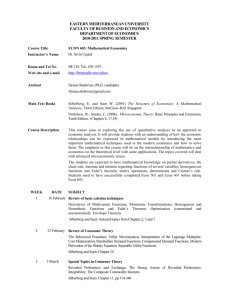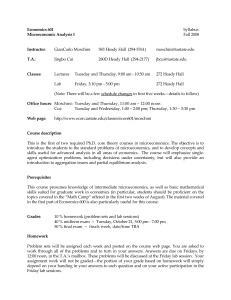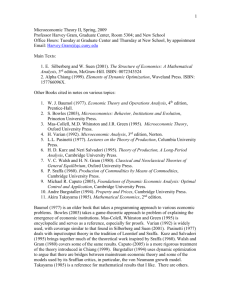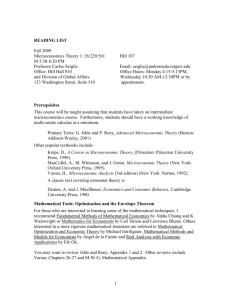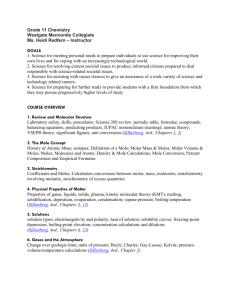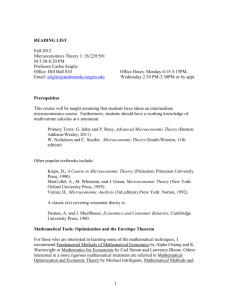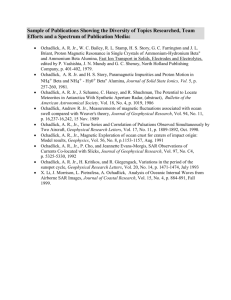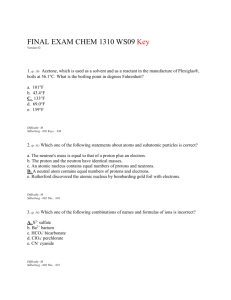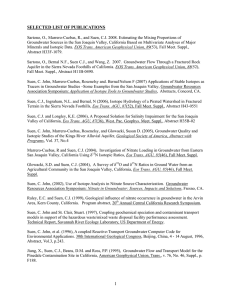ECON 8010 Microeconomic Theory I Prof
advertisement
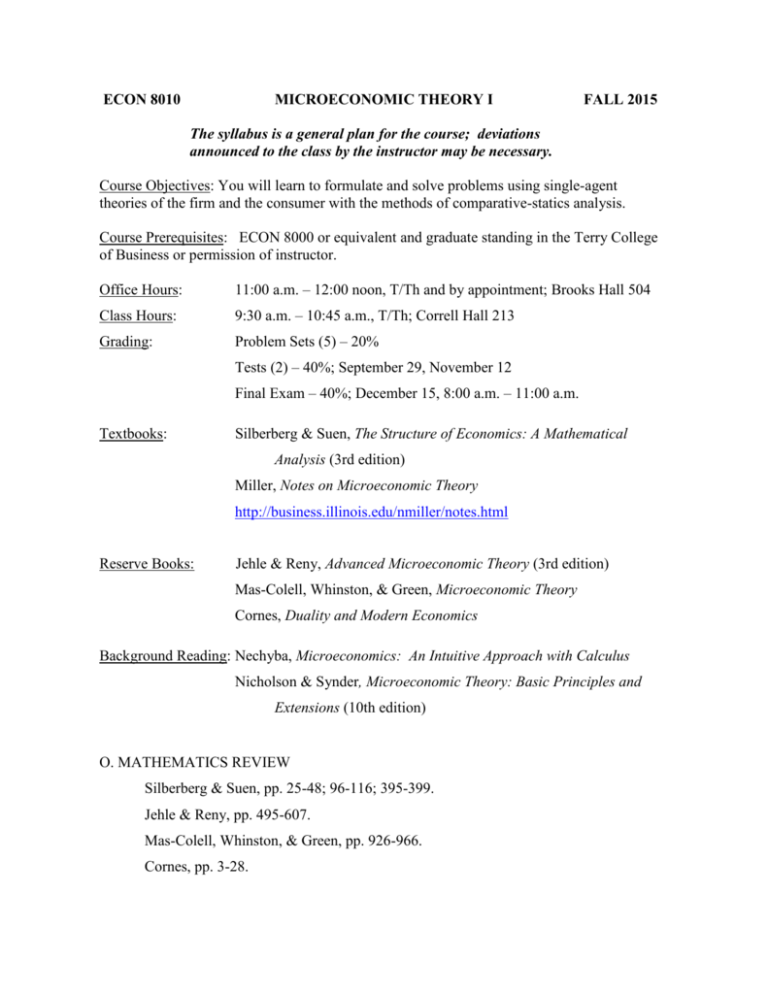
ECON 8010 MICROECONOMIC THEORY I FALL 2015 The syllabus is a general plan for the course; deviations announced to the class by the instructor may be necessary. Course Objectives: You will learn to formulate and solve problems using single-agent theories of the firm and the consumer with the methods of comparative-statics analysis. Course Prerequisites: ECON 8000 or equivalent and graduate standing in the Terry College of Business or permission of instructor. Office Hours: 11:00 a.m. – 12:00 noon, T/Th and by appointment; Brooks Hall 504 Class Hours: 9:30 a.m. – 10:45 a.m., T/Th; Correll Hall 213 Grading: Problem Sets (5) – 20% Tests (2) – 40%; September 29, November 12 Final Exam – 40%; December 15, 8:00 a.m. – 11:00 a.m. Textbooks: Silberberg & Suen, The Structure of Economics: A Mathematical Analysis (3rd edition) Miller, Notes on Microeconomic Theory http://business.illinois.edu/nmiller/notes.html Reserve Books: Jehle & Reny, Advanced Microeconomic Theory (3rd edition) Mas-Colell, Whinston, & Green, Microeconomic Theory Cornes, Duality and Modern Economics Background Reading: Nechyba, Microeconomics: An Intuitive Approach with Calculus Nicholson & Synder, Microeconomic Theory: Basic Principles and Extensions (10th edition) O. MATHEMATICS REVIEW Silberberg & Suen, pp. 25-48; 96-116; 395-399. Jehle & Reny, pp. 495-607. Mas-Colell, Whinston, & Green, pp. 926-966. Cornes, pp. 3-28. ECON 8010 Syllabus Page 2 I. INTRODUCTION Miller, pp. 1-4 Silberberg & Suen, pp. 1-14. Becker, “Nobel Lecture: The Economic Way of Looking at Behavior,” Journal of Political Economy, Vol. 101 (June 1993), pp. 385-409. Lazear, “Economic Imperialism,” Quarterly Journal of Economics, Vol. 115 (February 2000), pp. 99-146. II. THEORY OF PRODUCTION AND COST Silberberg & Suen, pp. 56-63; 151-152; 156-169; 175-188; 225-251. Miller, pp. 121-129. Jehle & Reny, pp. 125-138. Mas-Colell, Whinston, & Green, pp. 127-135. Cornes, pp. 104-109. III. THEORY OF INPUT DEMAND Silberberg & Suen, pp. 74-82; 84-91; 152-156. Miller, pp. 129-141. Jehle & Reny, pp. 138-154. Mas-Colell, Whinston, & Green, pp. 135-147. Cornes, pp. 109-133. Hamermesh, Labor Demand. Princeton: Princeton University Press, 1993, pp. 17-60. Grossman, "The Substitutability of Natives and Immigrants in Production," Review of Economics and Statistics, Vol. 64 (November 1982), pp. 596-603. Griffin, “The Impact of Affirmative Action on Labor Demand: A Test of Some Implications of the Le Chatelier Principle,” Review of Economics and Statistics, Vol. 74 (May 1992), pp. 251-260. Neary, “The Comparative Statics of the Ward-Domar Labor-Managed Firm: A ProfitFunction Approach,” Journal of Comparative Economics, Vol. 12 (June 1988), pp. 159-181. ECON 8010 Syllabus Page 3 IV. THEORY OF CONSUMER BEHAVIOR Silberberg & Suen, pp. 252-297; 314-341. Miller, pp. 5-28; 29-72; 87-101. Jehle & Reny, pp. 3-97. Mas-Colell, Whinston, & Green, pp. 5-80. Cornes, pp. 31-103; 200-202. Weymark, “Duality Results in Demand Theory,” European Economic Review, Vol. 14 (1980), pp. 377-395. Anderson, “Some Theory of Inverse Demand for Applied Demand Analysis,” European Economic Review, Vol. 14 (1980), pp. 281-290. Neary & Roberts, “The Theory of Household Behaviour under Rationing,” European Economic Review, Vol. 13 (1980), pp. 25-42. Snow & Warren, “Pigou’s Law and the Proportionality of Income and Price Elasticities of Demand,” Economics Letters, Vol. 132 (2015), pp. 136-138. V. THE ENDOWMENT MODEL A. Introduction Silberberg & Suen, pp. 302-305. Miller, pp. 100-104. B. Savings Silberberg & Suen, pp. 368-378. Miller, pp. 110-114. Mas-Colell, Whinston, & Green, pp. 732-759. C. Labor Supply Silberberg & Suen, pp. 299-301. Miller, pp. 104-106. Battalio, Green, & Kagel, "Income-Leisure Tradeoffs of Animal Workers," American Economic Review, Vol. 71 (1981), pp. 621-632. Snow & Warren, "Tax Rates and Labor Supply in Fiscal Equilibrium," Economic Inquiry, Vol. 27 (1989), pp. 511-520. ECON 8010 Syllabus Page 4 VI. UNCERTAINTY Silberberg & Suen, pp. 399-412. Miller, pp. 158-182. Jehle & Reny, pp. 97-118. Mas-Colell, Whinston, & Green, pp. 167-199. COURSE POLICIES Attendance: Students are expected to attend classes regularly. A student who incurs an excessive number of absences may be withdrawn from the class at the discretion of the instructor. Attendance may be taken randomly throughout the semester. Unexcused absences on more than three of these occasions will be deemed “excessive” for the purpose of this policy. http://www.bulletin.uga.edu/bulletin/ind/attendance.html. Examinations: Students are expected to take the tests and final exam at the scheduled times listed above. No make-up tests will be administered. If you are absent from a test, the weight of that test will be added to the weight of the final exam in determining your course grade. An unexcused absence from the final exam will result in a score of zero on that exam. There are two valid excuses for an absence from the final exam: (1) You have another exam scheduled for the same time or you have three exams scheduled within a 24-hour period, in which case you must petition in advance to take the exam at another time; see http://www.curriculumsystems.uga.edu/FinalExamConflicts/FinalExamConflicts.html); (2) The Office of Student Support Services verifies that you have a family emergency or personal illness, in which case you must arrange as soon as possible after the scheduled exam date to take the exam at another time. Academic Honesty: As a University of Georgia student, you have agreed to abide by the University’s academic honesty policy, “A Culture of Honesty,” and the Student Honor Code. All academic work must meet the standards described in “A Culture of Honesty,” found at www.uga.edu/honesty . Lack of knowledge of the academic honesty policy is not a legitimate justification for committing a violation of the policy. Questions related to course assignments and the academic honesty policy should be directed to the instructor.
